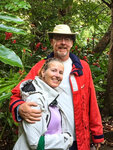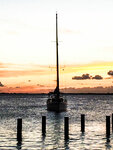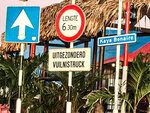



Last summer, on August 15, my wife Jenn and I left Manchester and headed up to the Hodgdon Yacht Services yard in Ebenecook Harbor in Maine (next to Boothbay Harbor). Quite a few Manchester boats go there each year. Our itinerary was to head down the US coastline and drop down into the Caribbean, go through the Panama Canal and then head to Galapagos, Marquesas, Tonga, Fiji and New Zealand.
By September 15 we had our first overnight sail, down to Salem Harbor.
From Salem, Jenn and I worked our way south, through Long Island Sound and transited “Hell’s Gate” in New York City (that is a story in and off itself), down the New Jersey coast to the tip of Cape May, which is home to the US Coast Guard training center. From there, we sailed up the Delaware River to the C&D Canal (“Chesapeake & Delaware”) which is the 14-mile man made canal that connects over to the Chesapeake Bay. In the Chesapeake we anchored off Kent Island and visited with family while attending the Annapolis Boat Show. After the show, we continued sailing south down the coast 120 miles to Hampton, Virginia for the “Rally to Antigua” on November 3rd. The annual event starts at the Bluewater Yachting Center in Hampton and finishes in Falmouth Harbor in Antigua. It’s organized by the Salty Dawg Sailing Association, which runs several days of seminars before the trip with information, training and weather briefings to prepare everyone before the rally.
From Antigua we went to Guadeloupe, Dominica, Martinique, St. Lucia, Bequia in the Grenadines and then on to Bonaire, an island principality owned by the Netherlands located just 50 miles off the coast of Venezuela.
We purchased Diva in 2012 in Ft. Lauderdale and sailed her up the coast (offshore) in 2013. Jenn and I then spent the next six years rebuilding her and sailing her in the summers while taking a variety of classes. We went to “Diesel Repair” school, “Generator Repair” school, we enrolled in “Sail Repair”, “Rigging Repair” and “Celestial Navigation” classes. We took “Safety at Sea” courses, which are highly recommended. But we also enrolled in “Wilderness Healthcare” and attended two Cruisers University at Annapolis boat shows.
These were all invaluable preparation for our trip, and everything we learned came in to play during the journey. In fact, so did elements I learned at the start of my sailing career at Manchester Sailing Association summer programs at Tuck’s Point. It’s a wonderful program and we hope to volunteer for it when we return. By the time we’d hit Bonaire, Jenn and I had completed about 2,500 miles of sailing from our origination point in Boothbay Harbor to where we were in the Caribbean. Four days into an eight-day trip, we were on the way to the Panama Canal and Bonaire was a stop we’d planned to do some scuba diving at the island’s award-winning underwater locations that accommodates all levels. Arriving in Bonaire, we cleared customs at 2:30 in the afternoon. The following morning, the government closed the port at 8 a.m. due to the COVID-19 coronavirus precautions. Had we continued on we would have arrived in Panama to a closed port as Panama had also closed because of the virus. If we had persisted, we would have then had to stay on the boat, at anchor, for a mandated 14-day quarantine before we could “petition” to come ashore. Our Panama agent suggested we stay put where we were. We agreed. In any case, all passages through the Panama Canal for boats under 65 feet were shut down, so we’d have been stuck at anchor in Panama for the duration. As we researched it, literally everywhere else we could have gone in the Caribbean was shut down to us as well, unless we want to sail back to the US with Florida being closest to where we were, that option wasn’t ideal.
Some countries like Ecuador are really getting hit hard with COVID-19, and thus the Galapagos have been shut down. So has New Zealand (our destination), and as of now the country will continue being shut down through the end of the year. We are COVID refugees!
Since our visas are good here in Bonaire for six months (and we can extend it,) we have decided to just stay put, especially as we were lucky and secured the very last mooring here on the island (Bonaire’s entire shoreline is a protected marine park, so no anchoring is allowed anywhere and a mooring is essential.)
Besides its beautiful reefs, Bonaire is known for its biggest export, salt. Historically, when ships would approach the island they would anchor in front of the pillar color that corresponded to the type and quality of salt that they wanted. Red, blue, white, orange, white, etc. We are trying to get pictures of all the pillars. Orange is our favorite. Nowadays the Salt Pier has become one of the top diving destinations here. In high season, it’s not uncommon to see 20 or more pick-up trucks with two to four divers each all diving the pier. The advantage to diving here during the COVID crisis is Jenn and I typically have the only vehicle in the parking lot, which is nice considering that diving in Bonaire is almost entirely accessed by beach.
Bonaire is an amazing mixture of cultures—Dutch, Spanish, American, etc.—and everyone seems comfortable speaking and reading English, Spanish and Dutch, as these signs show. There is also a pigeon language that is a mixture of Spanish, Portuguese, the native Indian language and Dutch, so it sounds a lot like happy German. The currency was standardized to the US dollar in Bonaire starting in 2010. Green backs abound and they are everywhere. After dealing with the EC (Eastern Caribbean currency) and the Euro for currency conversions, the Greenback is well, like going home.
We have been stocking the boat up on food and cooking great dinners on the grill with sundowners each night, doing boat projects. In fact, several weeks ago we rebuilt a head discharge pump. Anyone with experience with it knows it’s a messy, messy job. Jenn said there is not enough bleach in Bonaire to feel clean again (LOL!). On the positive side, we’ve been getting the best out of Bonaire. We can swim to a restaurant called Karol’s (for wifi) and there are 84 dive sites on the island —we are on number 16—and it’s a scuba mecca for those that enjoy the sport. The air and water temperatures are the same here, and the coral and fish and wildlife are just off the chart. We snorkel or scuba dive every day. We have a barracuda, about three feet long, that visits us in the afternoon now at our boat and tarpon that run four to six feet long that lazily cruises along under the boat. When we night dive, the flashlight beam draws in all the fish and the tarpon come up and suck up all the fish. I feel like I am taking a “karma hit” with each night dive as the tarpon will literally shadow us and come within six inches of us. I’ve been eyeball-to-eyeball with them, so to speak. They engulf the little fish.
Jenn and I just signed up for free-diving coaching with Carlos Coste who holds 11 world records. He is Venezuelan and a friend of a friend of ours here on Bonaire. In 2006 Coste broke the world free-diving record with a 140-meter immersion. We do not want to go deep, but 10 to 20 meters would be wonderful for checking the anchor and snorkeling the shallow reefs. We can use scuba for when we want to go down 100 feet to some of the local wrecks like the Hilma Hooker – a very notorious freighter that was caught smuggling drugs.
On the island there have only been three indeterminate COVID-19 tests on people in one family that display the symptomatology of the virus. They have been in quarantine the entire time and there has been nothing else here as of yet. Jenn and I read daily about the trials and tribulations back home and wish everyone well. It reminds me of the stories my grandmother, a nurse at Mass General, told my father about the Spanish Flu pandemic. There are many lessons to be learned in that history and I hope our “pandemic postmortem” takes those lessons into account.
For the time being, we’ll be stuck here in paradise. We hope to get the green light to head through the Panama Canal and hope to get to New Zealand by November, 2020. That’s it for this check in. Send our best to all our friends back home and we’ll write in again soon.